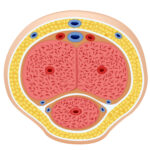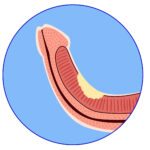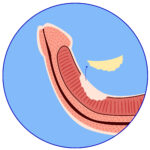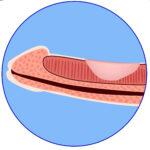Peyronie's Disease Illustrations
Peyronie's Plaque


Illustrations demonstrate a normal (left) and abnormal (right) cross section of the penis.
In the right image, a thickened scar can be seen, characteristic of Peyronie's Disease. This scar is often referred to as a plaque. Most plaques are made up of collagen, which constitutes most scars in the body. Because the scar is not elastic, when the rest of the penis expands with an erection, the scar remains fixed, resulting in a curvature. Depending on the location of the scar, you can observe curvatures in any direction. Additionally, if the circumferential fibers, trabecular fibers, or septum of the penis are affected, indentations, hourglass deformity, or other narrowing / tapering may occur.
Penile Plication



Illustrations demonstrate the surgical procedure penile plication.
With penile plication, sutures are placed on the opposite side of the curvature to straighten the penis. The sutures are permanent to limit the amount of curvature recurrence over time. Plication is typically performed in men with more modest curvatures (<70 degrees), although there are some providers that will do penile plications in all cases of Peyronie's. Side effects include possible mild loss of sensation, reduced penile volume (appearing smaller), palpable knots (sutures), and recurrence of curvature over time. Advantages of this surgery are that it is relatively minor and will correct the curvature immediately after the procedure.
Incision / Partial Excision and Grafting



Illustrations demonstrate the surgical procedure incision/excision and grafting for Peyronie's Disease.
With incision/excision and grafting, the penile plaque is either incised or partially excised followed by graft placement. Various grafts are used, with human pericardium being the most common. Incision/excision and grafting is reserved for the most severe of cases of Peyronie's Disease, typically when curvatures are >60-70 degrees, there is moderate hourglass deformity, or other severe indentations.
The surgery is only performed in men with good erectile function, as one of the primary side effects of surgery is worsened erectile function. Other complications include temporary or permanent loss of sensation, irregularity of the penis, variable changes in length, and recurrence of curvature over time. Men who undergo incision/excision and grafting are also the most likely to require a repeat surgery within the following year.
Advantages of this surgery include a higher likelihood of preserving penile length and partially addressing hourglass and indentation deformities at the time of surgery.
Penile Prosthesis

A penile prosthesis is a mechanical device that is placed within the penis during an outpatient or overnight surgery. The prosthesis allows the patient the ability to apply pressure to a pump in the scrotum, which then inflates cylinders in the penis, resulting in an erection. The surgery typically has a high satisfaction rate (typically >85%) and relatively low complication rate (2-3% chance of infection, with an avergae device survival of approximately 10 years). A penile prosthesis is used in cases where the patient has both Peyronie's Disease as well as severe erectile dysfunction. Men who are able to achieve an erection with pills (e.g. Viagra, Levitra, Cialis, Stendra) or injections typically do not undergo a penile prosthesis until the erections are no longer responsive to more conservative treatments.
Manual Modeling



Illustrations demonstrate how manual modeling is performed following treatments like Xiaflex.
The image in the left-most panel demonstrates counterbending, which is performed after maximally stretching the penis. The center panel shows straight stretching, and the panel on the right attempts to demonstrate straightening the penis with an erection. Following Xiaflex injections, we counsel patients to perform both straight stretching and counterbending (left and middle panels) for 30 seconds with each urinary void. Ideally, a moderate amount of force should be used. Additionally, we recommend that patients attempt to straighten the penis (but not go beyond straight) whenever they have an erection. These maneuvers are continued for 6 weeks after the last Xiaflex injection. We also recommend these maneuvers when other types of injection are used (e.g. interferon).
